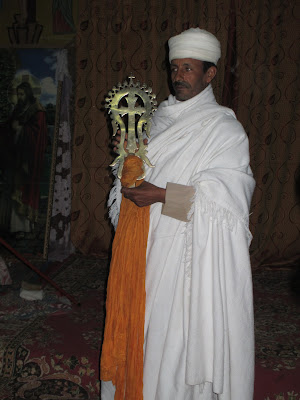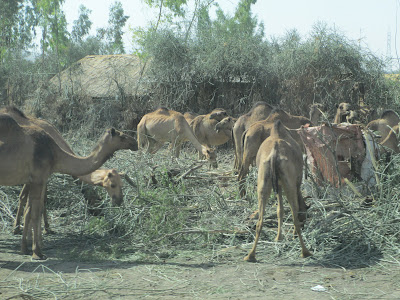On Sunday morning we departed Addis Ababa early in the morning for a flight to Lalibela! We could hardly contain our excitement. Over the last three years we have been soaking up as much information as we could about Ethiopia and we have been planning this trip, hoping that when the time came we would be able to organize travel outside of Addis. We were finally in Ethiopia and headed to the town of rock-hewn churches!
We took a short flight on Ethiopian Airlines and spent the whole flight looking out the windows. When we arrived in Lalibela we were amazed at our surroundings. We were really in the mountains, and there was nothing around us.
The van ride from the airport to the town of Lalibela was incredible. All along the way there were children running up to the road, waving at us while we whizzed by at a speed that could only be considered comfortable by those who drive this road regularly. Our drive took us higher and higher in elevation until we were finally winding through some populated areas and arriving in Lalibela.
We got to our hotel and quickly arranged for our tours for the day. We had enough time to visit half the churches before the noon to 2 pm lunch period when the churches are closed. Then we visited the other half of the churches after lunch.
The Bet Medhane Alem church is home to the very special Lalibela processional cross. This cross used to be displayed on a regular basis, but it was stolen in 1997. It was later returned and now it is guarded more closely and only shown off by a priest on Sundays. We just happened to be visiting the church as the priest was showing the cross and blessing people with it.
The churches of Lalibela were carved with simple tools in the 12th century. The goal was to create a "New Jerusalem" so that Orthodox Ethiopian Christians would not have to make pilgrimages all the way to Israel. It just so happened that we were in Lalibela one week before the Ethiopian Christmas (Genna). Pilgrims from all over Ethiopia were already arriving on foot. Many of these people were from rural parts of Ethiopia, so they were seeing white skin for the first time when we passed each other.
We took a short flight on Ethiopian Airlines and spent the whole flight looking out the windows. When we arrived in Lalibela we were amazed at our surroundings. We were really in the mountains, and there was nothing around us.
The van ride from the airport to the town of Lalibela was incredible. All along the way there were children running up to the road, waving at us while we whizzed by at a speed that could only be considered comfortable by those who drive this road regularly. Our drive took us higher and higher in elevation until we were finally winding through some populated areas and arriving in Lalibela.
We got to our hotel and quickly arranged for our tours for the day. We had enough time to visit half the churches before the noon to 2 pm lunch period when the churches are closed. Then we visited the other half of the churches after lunch.
The Bet Medhane Alem church is home to the very special Lalibela processional cross. This cross used to be displayed on a regular basis, but it was stolen in 1997. It was later returned and now it is guarded more closely and only shown off by a priest on Sundays. We just happened to be visiting the church as the priest was showing the cross and blessing people with it.
The churches of Lalibela were carved with simple tools in the 12th century. The goal was to create a "New Jerusalem" so that Orthodox Ethiopian Christians would not have to make pilgrimages all the way to Israel. It just so happened that we were in Lalibela one week before the Ethiopian Christmas (Genna). Pilgrims from all over Ethiopia were already arriving on foot. Many of these people were from rural parts of Ethiopia, so they were seeing white skin for the first time when we passed each other.
All of the churches were beautiful. Some were intricately carved on the exterior and others were intricately carved on the interior.
When it came down to it, there was really no question about which church was our favorite, though. Saint Giyorgis is by far the most picturesque and memorable. We approached the church from a hillside above and were looking down on the top, which is shaped like a cross. It is tall and slender with a very small footprint on the inside. It has weathered very well due to the drainage system and gutters that are set up from its roof, all original to the church.
The sides glow lime green in the sunlight from the lichen that has grown on the reddish brown rock. It is just amazing to know that each of these churches are one solid piece of rock, carved from the top down. The interiors are hollowed out, one chisel and chip at a time. The intricacy of the work is just astounding.
After we finished touring the churches we took the long hike back through town to our hotel. Along the way we talked with many locals. There were two high school boys, Dejen and Tomas, who told us about how they are temporarily living in Lalibela in order to go to school. Their family lives out in the countryside where there aren't any schools. They work part of the day in order to make enough money to pay some rent and then go to school the other part of the day. Their accommodations are very modest - a stick and mud house with a grass roof. In the rainy season, the roof leaks and their few belongings inside the house get drenched. In typical Ethiopian hospitality, Dejen and Tomas invited us to join them for a coffee ceremony in their home. It was really a highlight of our trip, being invited into the home of two young men who were delighted to spend a couple of hours visiting with us. They have access to a computer at their high school, so we are keeping in touch through email.
Our hotel was very nice and had a gorgeous panoramic view of the surrounding mountains and countryside. Our journey out of Addis was off to a great start!

































.JPG)